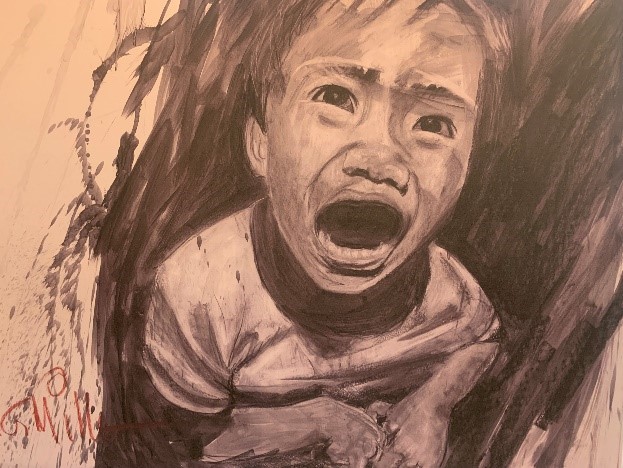Nearly two decades after its inception, The Gary Miller Art Project is preparing to release a new documentary and travelling exhibit. Accompanied by his new film, the project is a series of artwork created by Miller in response to his childhood experience at the Mohawk Institute. This exhibit aims to challenge historical narratives surrounding Indian Residential Schools, while confronting the realities of genocide. The film commemorates Survivors’ courageous efforts to preserve the truth for future generations.
With appearances from several Survivors and Miller, the film crew captured candid discussions, memories, and reactions to Gary’s artwork. The exhibit’s content is graphic and explicit. It illustrates some of the harsh realities’ children were exposed to while attending the Mohawk Institute, including images which depict nudity, sexual abuse and physical abuse.
About the Artist
Born in a strawberry patch on Six Nations reserve in the 1950’s, Gary was taken from his family and community, at the age of three, and spent 11 years of his childhood at the Mush Hole. In 1970, he attended the Ontario College of Art and is recognized around Canada for his distinctive style as an Indigenous artist.
As part of his art training, Miller learned how to paint from another Mush Hole Survivor-artist: Arthur Shilling. He crafted his visceral pieces in the early 2000’s; by that time, he was an expert in using composition, colour, line, figure, and brushstrokes to express the underlying outrage, and trauma of his lived experience.
“Art is a way of telling your story, channeling that anger and pain.”- Gary Miller
The canvas became a space where the trauma Gary experienced was not only acknowledged but also helped his healing journey unfold, becoming more open to talk about it and less angry. From large-scale paintings to elements of collage, each canvas is a collection of colours, imagery and words that convey the truth of his childhood, as he narrates what each piece reflects.
“It’s expression through emotion, a visual representation, feeling it out or verbalizing it gives you back your power.” – Sherlene Bomberry, Survivors’ Secretariat Board Member
Gary’s work speaks to a collective experience of trauma that few Survivors or artists are willing to explore. Gary is still healing from his residential school experiences. By sharing his work with fellow Survivors’ support, he can convey a deeper understanding of history.
About the Mohawk Institute
The Mohawk Institute, an Indian Residential School located in Brantford, Ontario, was operated by the New England Company, the Anglican Church and the Government of Canada from 1828 to 1970, making it the longest-operating residential school in Canada. Between 20-25 children were housed at the school in the early days of operation and these numbers grew to 200 children per year.
To date, the Secretariat has identified over 4,900 children who were forced to attend the Mush Hole. These children were forcibly taken from more than 60 First Nations communities.
“Perhaps, if people understood what we went through, the truth, the government policies, the intent of the system, the whole scope of genocide, they could have some understanding, empathy and acceptance.” - Gary Miller
The Gary Miller Art Project
The Gary Miller art project had its first residency in 2003, at the Woodland Cultural Center when Tom Hill was the museum’s director. The long-term project aims to bring Millers’ art to other Survivors and impacted communities of the Mohawk Institute free of cost.
This new documentary film will accompany the exhibit, with installations at Urban Art Galleries, Universities, and Museums in North America over the next few years.
Gary is currently co-authoring a book and is aiming to submit this new documentary in the upcoming 2024 film festival season. The film is planned for release in May of 2024, directed by Cher Obediah, a Mohawk/Obijway women of the Turtle Clan from Six Nations, Ontario.
“A very unique exhibit, he’s a master painter.” – Dr. Neal Keating, Curator of the Gary Miller Art Project.
On behalf of Survivors’ Secretariat, we would like to extend a sincere thank you to Gary and the crew for creating a film that encourages and supports the Survivor-led truth-telling journey about what happened at the Mohawk Institute in its 140+ years of operation.
We would like to extend our gratitude to all Survivors who continue to share their truths. We honour your strength, commitment and the bravery it takes to speak on such sensitive subjects.
“Survivors’ telling their stories is a kind of social force, there is power in them telling their truths.” – Dr. Neal Keating, Curator of the Gary Miller Art Project.
Nia:weh, Miigwetch!
